With Stanford University's ambitious expansion plan nearing the finish line, hundreds of Stanford students, public school advocates and elected leaders from surrounding communities rallied in Palo Alto on Tuesday to demand that the university do more to address the impacts of its increasingly divisive proposal.
On a day that featured more than 150 students chanting at King Plaza, about 400 spectators cramming into City Hall and roughly 140 speakers addressing the Santa Clara County Board of Supervisors during its rare meeting in Palo Alto, supervisors were besieged with requests that Stanford should be required to provide more housing and transportation services.
With a standing-room-only crowd of more than 250 people packed into the Council Chambers and many others following the meeting from the spillover area in the City Hall lobby, the board heard from area residents, Stanford students and elected officials, many of whom requested that Stanford be required to fully mitigate the expected impacts of its expansion on housing and traffic. Supervisors also heard from several advocates of Stanford's expansion plan, who emphasized the value that Stanford brings to the region and urged the county to approve its expansion request.
One issue that remained unresolved by the end of the meeting was Stanford's commitment to the Palo Alto Unified School District. Last month, the district's Board of Education celebrated a letter that it had received from Robert Reidy, Stanford's vice president for land, buildings and real estate, stating that the university remains "unequivocally committed" to the $138 million agreement that it reached with the school board last spring. That tentative agreement hinged, however, on Stanford negotiating a development agreement with the county, a condition that prompted the county to back away from its own negotiations with Stanford.
At its Sept. 24 meeting, school board members and Superintendent Don Austin lauded Stanford for remaining committed to providing funding for schools, with the understanding that it no longer depends on a development agreement. At that time, board member Ken Dauber called Reidy's Sept. 23 letter a "rock solid commitment" that is "as clear as can be," while board member Shounak Dharap celebrated it as a "great agreement" that is "not conditional on a development agreement."
On Tuesday, however, school officials learned that their celebrations may have been premature and that Stanford's commitment isn't as unequivocal as they had believed it to be. Rather, it remains dependent on a development agreement between Stanford and the county, the very condition that doomed the prior deal between the two educational institutions. Reidy confirmed that under direct questioning by Board of Supervisors President Joe Simitian, who asked him whether Stanford's commitment is as "rock solid" as school board members made it out to be.
"We made it very clear that those funds will be delivered, provided – and appropriately provided – that we have predictability for the future in the form of a development agreement," Reidy told the board.
Simitian also pointed to a recent analysis by the county showing that Stanford's tax-exempt status results in a revenue reduction of $95.9 million for all local jurisdictions in the county, including $44.5 million for the Palo Alto Unified School District. Simitian noted that any time more students are added to district without additional revenues from property taxes, the per-pupil amount available for instruction goes down. This particularly holds true for "locally funded" districts like Palo Alto, which rely largely on local taxes to pay for education.
"By virtue of that status, it's always going to mean that you'll have fewer dollars per kid," Simitian said.
Simitian told Reidy that absent contributions to the school district, the Board of Supervisors might struggle to make the required legal finding that the Stanford project is not "detrimental to public health safety and general welfare."
"I don't know how we can possibly make the finding that the proposed use will not be detrimental to public health, safety and general welfare if it means every student in the Palo Alto Unified School District will receive $5,000 less in the way of instruction and a 10% reduction (in funding)."
Stanford students brought their own concerns to Tuesday hearings. About 200 undergraduate students, many affiliated with the group SCoPE 2035 (Stanford Coalition for Planning an Equitable 2035), came to the meeting to insist that Stanford offer more housing and transportation services for employees. Some urged the board not to negotiate a development agreement with Stanford unless the negotiations are transparent and Stanford agrees to provide more affordable housing and meet its commitment to the local school district.
Graduate students, many affiliated with the group Stanford Solidarity Network, similarly called on the university to do more to support its workforce by providing more affordable housing and child care services. Members of the group argued Tuesday that Stanford's graduate students face a significantly higher financial burden than their counterparts at other elite universities.
The group also estimated that only about 15% of existing graduate-student housing at Stanford can be considered as "affordable," which they define as costing no more than 30% of the resident's income.
"This crisis is exacerbated for students with significant childcare and dependent healthcare expenses, as well as international students with visa stipulations prohibiting their families from receiving public benefits and barring dependents from working," Stanford Solidarity Network said in a news release. "Though the Stanford University administration emphasizes that 'affordability' is one of its key concerns at present, current development, as well as future construction under the GUP, is projected at rent levels that will only further intensify the crisis of affordability for graduate students."
Alexa Russo, a member of Stanford Solidarity Network, said the group is concerned about the impact of Stanford's expansion on both staff and graduate students.
"While we do different jobs, we are linked by a dire need for affordable housing and concerned about equity implications of Stanford's development plans, not only for us but for the community as a whole," Russo said.
Justine Modica, who was one of about two dozen graduate students who addressed the board, also joined the rally before the meeting, where she suggested that Stanford should devote a greater share of its $27-billion endowment to assist its graduate students. Modica said that while she doesn't have children, Stanford's failure to provide more assistance places a significant burden on those graduate students who do.
"Stanford cuts its graduate students no deals for child care. Even the most affordable options are 130% of our yearly stipend," Modica told a crowd of more than 150 at the rally. "If I had a child, I would not be able to complete my studies while keeping my child alive."
The board also heard from supporters of Stanford's expansion, most of them faculty members at the university. Jonathan Levin, dean of Stanford Graduate School of Business, said Stanford's growth is "intrinsically tied up with the excellence of the university." He urged the board to negotiate with Stanford.
"I'd really urge you all as supervisors to at least enter into discussions with Stanford and explore some of the possibilities," Levin said.
The Tuesday meeting was the penultimate hearing on Stanford's application for a general use permit that would allow the university to build 3.5 million square feet of new development by 2035. Often referred to as the largest project in the county's history, the GUP calls for 2.275 million square feet of new academic space and 2,600 student beds. The university has also proposed building 550 housing units for faculty and staff and 40,000 square feet for child care facilities. The county has included in its conditions of approval a requirement for Stanford to build at least 2,172 housing units for staff, a requirement that Stanford has steadfastly opposed.
Stanford has also refused to budge from its position that a development agreement is the best – and potentially the only – way to make its expansion possible, notwithstanding the county’s reluctance to negotiate such an agreement. The university reiterated its position this week, with Reidy arguing in a letter that a development agreement is necessary to give Stanford the certainty it needs before it can offer community benefits.
"It is important to emphasize that a development agreement is the only legislative tool that can provide such predictability – there is no other," Reidy wrote on Oct. 21. "It is undisputed that County laws and regulations that affect Stanford's academic and housing development under the General Use Permit can be changed absent a development agreement."
County officials have rejected this position in the past, noting that the county has never approved any project (including Stanford's last GUP in 2000) using a development agreement, a tool that didn't even exist before the county agreed to make it available in October 2018.
County staff had also argued that Stanford's offer fails to deliver the type of benefits the university has suggested it does. Stanford had argued that its offer includes "extraordinary benefits," which it estimates would cost more than $4.7 billion. County staff have rejected that figure, noting that Stanford is including in its tally many aspects of the project itself, including graduate-student beds. Actual benefits, according to the county, total only about $168 million, roughly 3% of what Stanford claims, Deputy County Executive Sylvia Gallegos told the board at a prior hearing on the expansion project.
With public comments stretching for nearly four hours, the board didn't deliberate on the general use permit, opting to continue its hearing to Nov. 5, its final scheduled meeting on the Stanford application. That meeting is set to begin 1:30 p.m. at the County Government Building, 70 W. Hedding St., San Jose.
The Tuesday meeting was preceded by a boisterous rally in which speakers also urged the university to do more for its workers and graduate students. Armed with signs (some of the messages read "Housing for All," "We stand with workers" and "Maximum Affordable Housing Now") and a bullhorn, more than 150 students chanted and spoke about the need to hold Stanford accountable.
"Student pressure is absolutely vital in forcing Stanford to create decisions that are inclusive in their scope and make sure to take into account repercussions that go beyond the Stanford campus," Erica Scott, president of the Associated Students of Stanford University, told a cheering crowd, which minutes later broke into chants of, "Hey hey, ho ho / Exploitation's got to go!" and "Housing is a right! That is why we have to fight!"
Students weren't the only speakers to offer reservations about Stanford's growth plan. Council members from various cities around Stanford, including Palo Alto, East Palo Alto and Menlo Park also pushed for "full mitigation." East Palo Alto Councilman Carlos Romero urged Stanford to expand its network of Marguerite shuttles to serve workers in nearby commuters.
"It is critical that the low-income workers in East Palo Alto who work and staff the various areas at Stanford should have the ability to get to Palo Alto through that service," Romero said. "It's a type of TDM (transportation-demand management) that both the cities and Stanford can benefit from."
Menlo Park Councilwoman Betsy Nash also requested more transportation services from Stanford, which she said are necessary to address the city's traffic and housing challenges.
"It's hard to overstate how serious the adverse impacts of that expansion will be," Nash said.
Related content:
• San Mateo County cities fume as Stanford rebuffs their funding requests
• Guest Opinion: Stanford's commitment to Palo Alto schools must be honored

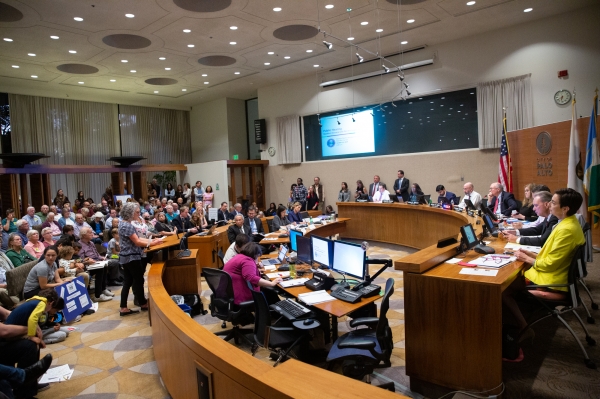
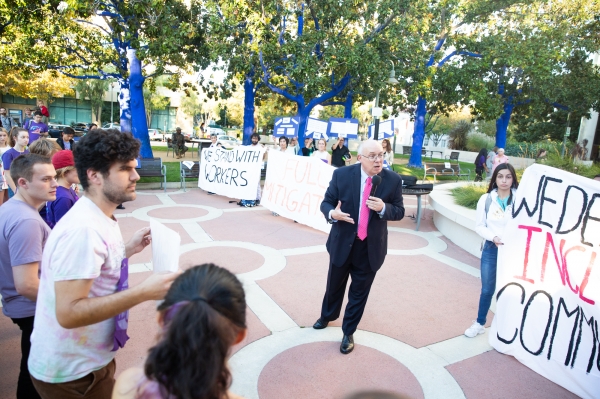
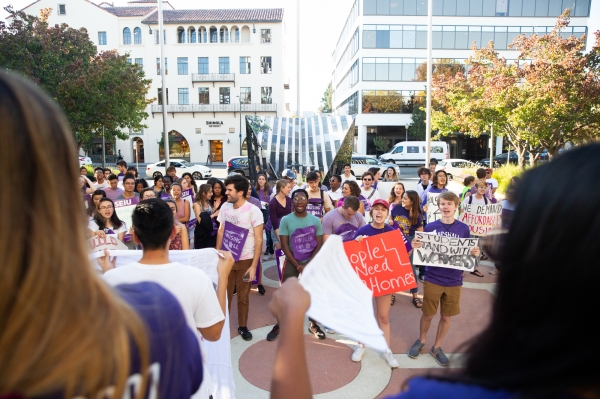

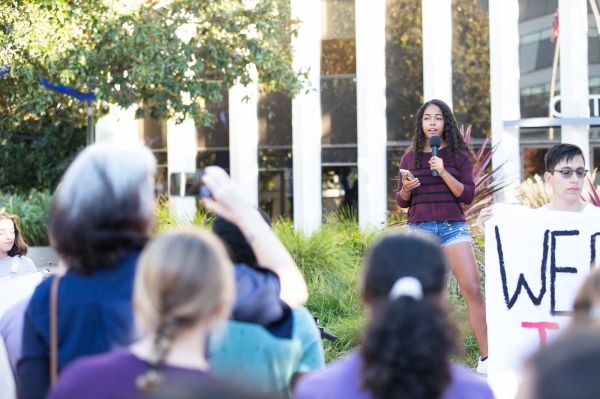

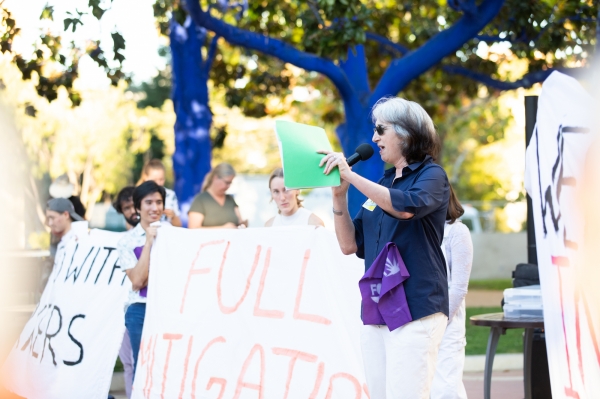

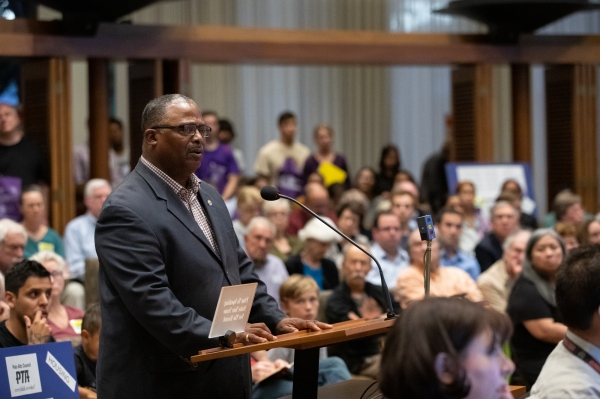


Comments
Esther Clark Park
on Oct 22, 2019 at 10:11 pm
on Oct 22, 2019 at 10:11 pm
Stand firm Stanford. Stand firm. Do not give in. Do not.
Talk about groupthink and intolerance.
Esther Clark Park
on Oct 22, 2019 at 10:12 pm
on Oct 22, 2019 at 10:12 pm
Housing is not a right.
Green Acres
on Oct 22, 2019 at 10:48 pm
on Oct 22, 2019 at 10:48 pm
[Post removed.]
Old Palo Alto
on Oct 23, 2019 at 12:18 am
on Oct 23, 2019 at 12:18 am
I'm old enough to remember Stanford dedicating land for the expanded public Page Mill Road to mitigate car traffic for the Stanford Research Park and later, to build Escondido Village, it had to set aside land and build 2 new public elementary schools. Sensible growth on congested areas like ours requires mitigating community impacts in full.
Independent, yes housing is not a right, but any person or entity who wants to build anything in the US is subject to local zoning codes which are apolice power to benefit safe and general welfare And for bjg orojects like this one, CEQA demands mitigation for environmental impacts such as traffic and jobs-housing imbalances,
Back in the dark ages before the birth control pill, when pregnant women could be fired from any job so few earned college or graduate degrees or worked outside the home, most Stanford students were not married, had no kids, the wife stayed home to cook and clean "for free", and there was still a lot of open land left with lots of cheap new housing and older delapidated rental houses available so no one talked about any zoning "general welfare" requirement for affordable housing for low income Stanford students, post docs and other young faculty much less the blue collar workers to keep the campus running.
Now Stanford says it simply can't build over 3,000,000 square feet of gotta-have new office space and also mitigate its Biggest Ever Growth Dream on Campus by building enough housing on the land it owns in 2+ towns and 2 counties to prevent more Midtown Manhattan style gridlock and packed mass transit to affordable housing far away. (Want push-em-in style Tokyo subways here? Water shortages?)
And "Too bad!" Stanford says to taxpayers who without more affordable housing to mitigate its community impacts for its planned office space expansion...we taxpayers will continue to subsidize the Stanford Trust with Section 8 housing, WIC and food stamps for the 1,000 unhoused extra graduate students and post-docs this growth will entail... since, pity poor Stanford with its $20,0000,0000,000+ trust endowment, it just can't afford to take care of its own growth's costs.
Funny, it now has built enough housing to roof all its unrgraduates and pay for their tuition if their parents don't earn enough.
You believe that pity me cry from Stanford? I have a bridge in Brooklyn to sell you.
For some reason, it pays all its grad students, post docs and junior faculty members local poverty wages but expects us taxpayers to fund welfare benefits to an ever increasing number of them to keep them all feed and housed.
For its last big expansion of the hospital (where my insuance is not accepted) what did we get? Gridlock at every major City intersection for hospital shift changes, 2 extra lanes on Sandhill Road running by the Stanford shopping center, and new paint for "traffic calming" on short stretches of Foothill and Alpine by the school's golf course. Whoopie.
Tonight at City Hall, I listened on the radio to Stanford graduate students and post-docs at the County hearing talking about their housing and childcare costs and suddenly I thought, "What would Jane Stanford do today?" instead of the hardball negotiators from the Stanford Trust's land office with the orders they have from the Stanford Trustees to build, build, build, as if when the building footprint growth stops, something bad will happen. Stanford is our local Winchester Mystery House.
After Jane Stanford and her husband lost their only child to sickness, they decided all California children - both male and female - would be their children. They built a university in their son's name to make people remember their beloved boy and also to whitewash Leland senior's Railroad Robber Baron - Junk Bond King reputation. As Baptists they had their Memorial Church open to use by all faiths, very unusual for their day but they were early progressives. The idea that any of her graduate students and post docs would be on public assistance to have enough to eat while her family's trust sits on over $20,000,0000,000 would horrify her.
Jane sold all her jewelry to raise funds and paid all faculty salaries for years out of her private pocket to keep her son's university alive when the victims of Leland senior's worst junk bond escapade tried to break the Stanford trust to recoup their losses. And, history still does not know who killed her with strycnine in her soda water...
It's time for Stanford to think what would Jane do. The idea that most Stanford graduate students with children can't afford to live anywhere on or near the campus without welfare and there is a growing shortage of any local affordable child care for them would curl her toes. The idea that everyone in the nearby communities is stuck in ever increasing gridlock every work day - cursing her son's university's growth - and local public schools' budgets are abused by the trust's legal status are not a credit to her university.
Stanford, go back to the drawing board, put all your lands on the open table to talk about all community impacts and possible regional mitigation methods for your desired growth. Not just the small bit under discussion now. For mitigations, you must include all the parcels you own in College Terrace and Professorville, your open space in the hills, Stanford Reaearch Park, Stanford Shopping Center, the Vi, Stanford West housing, SLAC, the Rosewood Hotel, commercial offices on Sandhill Road, Stanford Park Hotel, your land on El Camino in Menlo Park, your many offices at the Palo Alto Baylands, and your huge new Redwood City campus, By looking at ALL that land, working with all the local towns and counties, together we can figure out how we want housing, schools, utilties, and transit in and around Stanford to work in the next 25 years. We can't do this sort of planning piecemeal with just one County today reviewing just one small part of the puzzle.
Midtown
on Oct 23, 2019 at 12:58 am
on Oct 23, 2019 at 12:58 am
Full mitigation needs to apply not just to Stanford, but also to these major employers: Google, Facebook, Microsoft, Palantir, Tesla, VMWare, SAP, Tibco, etc.
Esther Clark Park
on Oct 23, 2019 at 6:42 am
on Oct 23, 2019 at 6:42 am
@oldster, re CEQA - the final EIR for the GUP said no more housing mitigation above Stanford's proposal was required. The county's own analysis showed more housing forced on Stanford would lead to more congestion and traffic locally versus folks commuting in and commuting out.
Registered user
College Terrace
on Oct 23, 2019 at 7:07 am
Registered user
on Oct 23, 2019 at 7:07 am
I would like to thank Joe Simitian for running the show last night. We're lucky to have his thoughtful and fair leadership.
Another Palo Alto neighborhood
on Oct 23, 2019 at 11:15 am
on Oct 23, 2019 at 11:15 am
Somebody please remind me how many new staff jobs Stanford expects the 2.275 Million square feet to accommodate? If these are bio labs, it might be 1000 new employees. If these are people sitting in front of computer displays, it could be 15,000 new employees.
And, as I've noted before, all big employers in the area need to provide "company housing" because massive growth has overtaken the normal processes through which affordable housing "just happens" through market forces. (References have been posted repeatedly on this repeatedly by many people in all these threads.)
"Market failure occurs when individuals acting in rational self-interest produce a less than optimal or economically inefficient outcome."
South of Midtown
on Oct 23, 2019 at 1:14 pm
on Oct 23, 2019 at 1:14 pm
Is it true that Stanford plans to add between 9,600 - 10,000 students and employees during the period of time covered by the development agreement? If so, that very large number should be featured prominently in every article and discussion of housing, traffic and other community impacts.
Fairmeadow
on Oct 23, 2019 at 3:06 pm
on Oct 23, 2019 at 3:06 pm
Note to PAUSD board members and superintendent: Simitian runs circles around you. Listen more closely to him next time.
Esther Clark Park
on Oct 23, 2019 at 7:49 pm
on Oct 23, 2019 at 7:49 pm
@Anon - no, there is no market failure. There are many high paying jobs located here that permit people to bid up the price of housing. Other folks'income growth has not kept pace and so they are outbid for housing around here. Also, the Fed and the ECB and the UK central bank and China and others injected $7 trillion into world economies to prevent a depression, from 2008 until today. Asset prices have risen as a result. That has distorted the market. The issue is income hasn't grown for some folks, and thus an affordability issue for some and expensive housing overall.
Crescent Park
on Oct 23, 2019 at 8:17 pm
on Oct 23, 2019 at 8:17 pm
Thank you Oldster for your email.
The history of Jane Stanford selling her jewelry to support Stanford during lean times is remarkable and speaks to the Founder's intentions.
Stanford, unfortunately, thru their "never enough" expansion and lack of community partnership, has become a cancer on the surrounding communities.
It is time for all to say NO! Stanford must fully mitigate their expansion and that includes Stanford paying for Stanford student's/staff's and professor's children's education.
With an endowment of 20-27 BILLION dollars, Stanford does not lack the funds to pay their FAIR share.
On the other hand, Palo Alto is in serious financial straits with their unfunded pension fund obligation rising each year.
Interesting what Palo Alto could do with the 44.5 million dollars lost every year from Stanford's tax exemptions (Daily Post-page 4, 10/14/19.
Supervisor Simitian, the gold standard in his service to Palo Alto, was undercut by Mr. Collins. Mr. Dauber and the PAUSD. They should be ashamed for negotiating a "back room" deal with Stanford, which is now being used as bargaining tool by Stanford. What a surprise.
I thank all who attended last night's meeting, spoke and supported Supervisor Simitian in his efforts to have Stanford meet their obligations to the surrounding communities.
I hope the entire Board of Supervisors supports Supervisor Simitian and says NO to Stanford's unreasonable demands and expansion plans. Thank you.
Green Acres
on Oct 23, 2019 at 9:25 pm
on Oct 23, 2019 at 9:25 pm
"Supervisor Simitian, the gold standard in his service to Palo Alto, was undercut by Mr. Collins. Mr. Dauber and the PAUSD. They should be ashamed for negotiating a "back room" deal with Stanford, which is now being used as bargaining tool by Stanford. What a surprise."
Actually, PAUSD negotiated a deal that provides tens or hundreds of millions of dollars for our students. I don't know if Simitian is a "gold standard". I do know that he didn't mention the schools in his speech before the meeting yesterday, which upset a lot of parents who were there. I also don't know what his plan is to actually get money for the schools from Stanford. I don't know why Simitian seems to have gotten sideways with our school board but I don't think it speaks well for him.
Gunn High School
on Oct 24, 2019 at 1:12 am
on Oct 24, 2019 at 1:12 am
Supervisor Simitian is negotiating a comprehensive package for cities and schools and open space and traffic and air quality and etc.
It is short sighted and close minded of PAUSD and Dauber and Collins to only think of just the school district and screw all else.
Full mitigation!
Old Palo Alto
on Oct 24, 2019 at 4:00 am
on Oct 24, 2019 at 4:00 am
A big irony in all of this as I think more about what would Jane do, is how much the Stanford trustees act like the richest British aristocrats and their land agents. The Stanford Land Office acts like the large British landower's agents who to improve an estate's revenue frequently threw peasant farmers off their lands when they could not pay rent during crop failures such as during the Irish Potato Famine.
It haunts me mamy fo the statements Tuesday night from the post docs and graduate students. The single Mom who said the Land Office required her to rent a 2 room apartment instead of a one bedroom for herself and her one child. She csn't afford a 2 room given her low stipend and lack of affordable child care. The Dad who has to have his family live in Walnut Creek to find affordable housing and child care and his horrid daily commute. The number speaking anonymously fearing retaliation such as one who lived in an vehicle on El Camino. The African-American lady saying the university only has 2% of grad sutdents and post docs of her ethnicity due to high housing and childcare costs. On the hearing video you can see the parade of those young scholars all dressed like they shop at Goodwill...
(History tidbit: Lucy Stern used to have at her Cowper Street home during the Great Depression a closet of clothes for Stanford students to use.)
Meanwhile, I know Stanford faculty living on campus were shocked about a year ago when the County started sending them tax bills after the courts said those long ground leaseholders had to pay property tax. Stanford is paying these new assessments for 1-2 years as charity, then the leaseholders must pay the taxes. That will force many retired leaseholders to sell.
But, did not the Trust lease some land to the Vi for the noble purpose of clearing out older and retired faculty to free up more campus housing for new faculty? The Vi.... where you can't sell a unit til the building manager finds a buyer willing to pay the price it sets and where you must pay for parking even if you don't drive or are dead while your heirs wait for a buyer approved by the manager. What nice folks.
There's a good reason many of the Robber Baron Stanford's first faculty tenants refused to live on campus on a long leasehold and instead choose home full ownership off campus. Who wants to be a hat-in-hand begger for whatever housing and at whatever cost and terms the Trust or its agents allows?
Meanwhile, in London, United Kingdom, much of the most expensive land is owned by the Duke of Westminster who never sells, just allows ground leases , and his net worth rises every year. Sounds like the Stanford Trust?
I remind the trustees, if you treat too many peasants badly they eventually revolt.
I am a big supporter of land rights, but in the case of the Stanford land trust created by special legislation in Sacramento pushed through by old Leland himself using all the influence he had in order to shelter his railroad profits, avoid taxes, and reduce public oversight for his " no profit" activities - I see too much of arrogance, unaccountablility, old world aristocrat behavior.
The simple fact the current Stanford growth plan on the table is called the "Community Area Plan" but does not include much beyond the inner campus - not the shopping center, the Research Park, hospital, etc. - shows what a disingenous smoke & mirrors this GUP is for any sane mitigation discussion. The fact is, Stanford is now so big it is essentially a city. It is not a little "farm" with a few classrooms or a Downtown Abbey with a few domestic workers and always happy peasant farmers and neighbors.
Registered user
Adobe-Meadow
on Oct 24, 2019 at 8:22 am
Registered user
on Oct 24, 2019 at 8:22 am
It is time for SU to recognize that RV's used by SU workers on ECR are a legitimate issue to be contracted for in any upcoming agreements. Since "housing" is the current topic and where to put every one then SU needs to dedicate a portion of their back property where they have their maintenance equipment to the SU workers that reside in RV's. The workers can be provided a gate pass to park there - and that gate pass may be issued to a main contractor who then provides to his workers. In that way they will be off the street and have a place to shower and dump any hazardous material. They will not be required to move on game days in this back location.
We keep circling the wagons here on this topic. Every city is working this issue. Time to formalize and recognize the issue with a positive plan. MV is still working their approach and probably will put this up to the voters. Time for PA to put this to the voters so that the city has a resident goal in place and is not subject to numerous non-profits who work these issues via the legal system. And if the famous legal eagles wish to object then sue them. They do not run the state. They are not the tax payers. And the tax payers need to step up here. Tax payers vs the legal groups - time to take that on.
Menlo Park
on Oct 24, 2019 at 9:34 am
on Oct 24, 2019 at 9:34 am
I listened to about two hours of the public testimony at the GUP hearing. It was shocking to hear what the service workers (low-paid graduate students & adjunct faculty fall into this category) put up with from Stanford. All the undergraduates who spoke also insisted on full mitigation.
The only people who spoke in favor of the GUP were construction professionals drooling over the fat building contracts (duh) and wealthy faculty eager to expand their academic empires. The latter's arrogance and contempt for our communities requests was on full display.
Menlo Park
on Oct 24, 2019 at 9:38 am
on Oct 24, 2019 at 9:38 am
Why is Bob Reidy still in charge at Stanford? His disingenuousness, or worse, about the deal on schools is only one example of why he does a disservice to Stanford with every breath. The recent air conditioning fiasco on campus, and the untruths and cover-up attempts afterward, were on his watch. And yet he stays. The Arrillaga gym that was built without showers? On his watch. The student golf course, which destroyed pedestrian and bike paths to campus, heavily used by students, faculty and employees? On his watch. The dreadful signage, on campus and for the Marguerite (bus stops and bus head signs as lacking in information as possible), which have only been improved in recent years? On his all-too-long watch. The list goes on and on. For VP of land, building and real estate, Stanford needs someone with vision and a commitment to the kind of excellence Stanford claims its students and faculty possess. Reidy has never been such a person. When Stanford got a new President, people aware of what Reidy does - and more importantly doesn't do, never would do, and can't even imagine that he should do - thought he would be spending more time with his family. Who knows why that hasn't happened yet. But really, the whole raft of issues here -- GUP - mitigation - decency toward the community, workers, grad students -- could be resolved if Stanford's real estate division had ethical, thoughtful, intelligent leadership.
Barron Park
on Oct 24, 2019 at 11:13 am
on Oct 24, 2019 at 11:13 am
"The only people who spoke in favor of the GUP were construction professionals drooling over the fat building contracts (duh) and wealthy faculty eager to expand their academic empires. The latter's arrogance and contempt for our communities requests was on full display."
Well said!! Its AL ABOUT THE MONEY
Can't they EVER stop expanding?!
Barron Park
on Oct 24, 2019 at 11:16 am
on Oct 24, 2019 at 11:16 am
and for sure it it ALL about the money. Regardless of mitigation, I really dont think there is room on the Peninsula for this any more
Professorville
on Oct 24, 2019 at 11:31 am
on Oct 24, 2019 at 11:31 am
If there is an economic criminal in our midst it is Simitian. The disaster, the Buena Vista trailer park well predicted by those who can count is close to being total. Follow the Palo Alto online a couple of years ago. You cannot fight gentrification unless you want to risk "unfairness" and generalized financial dysfunction. Don't kill the golden goose. The barbell effect (San Francisco and others): the upper middle class can afford but the rest of the middle class must leave while those who get a rent subsidy get to stay. On and on in economics classes. How can you build "affordable housing" anyway in Palo Alto when a rental unit (land valuation again) costs around 750k? Prediction: there already is a crash underway. Apartment house investors are pulling out of California because of rent control. The San Francisco disease of rent control with gruesome Newsome and chairman Chui leading the charge. The second woman ever to win the Nobel prize in economics has been announced.
George Drysdale initiator and educator
Another Palo Alto neighborhood
on Oct 24, 2019 at 12:29 pm
on Oct 24, 2019 at 12:29 pm
Posted by george drysdale, a resident of Professorville
>> If there is an economic criminal in our midst it is Simitian.
I see. You think anyone who disagrees with you is a "criminal". I guess that makes me a criminal, too, then, because I disagree with you about a lot of things. "Whatever."
Professorville
on Oct 25, 2019 at 11:02 am
on Oct 25, 2019 at 11:02 am
It's just soooo easy to spend other people's money. Tax the rich! Tax the corporations!
To the posters who tie this dicussion to Stanford's endowment (which has almost zero to do with their community impact) and demand Stanford pay their "fair share" - Well just because the premier university in the world can theoretically afford to pay for all free stuff you want doesn't make it right to require them to do so. Many of these comments go pretty far down the path of "Strangling the Golden Goose" - Stanford is a huge part of the lifeblood and identity of Palo Alto and should be celebrated, not attacked.
I'm in for reasonable economic balance that applies equally and fairly to all major employers in our area, and I agree Stanford should have to reasonably mitigate the costs of expansion on the surrounding community. For sure Stanford's tax exempt status should be a part of this discussion as compared to Facebook, Google, HP, Palantir, etc - but Stanford also make so many more amazing contributions to our community than the private employers do - they also need to be fully credited in this area.
Stanford
on Oct 25, 2019 at 12:54 pm
on Oct 25, 2019 at 12:54 pm
> because the premier university in the world
Dan, I stopped reading after I read this preposterous, ignorant view of universities.
Maybe you meant the richest? the most predatory? the greediest?
Registered user
Duveneck/St. Francis
on Oct 25, 2019 at 1:11 pm
Registered user
on Oct 25, 2019 at 1:11 pm
Dear County of Santa Clara,
I suggest that you treat every single Stanford building project separately. No GUP. No large-scale development agreement.
It is too complicated to project or understand what the impacts of unfolding multiple projects amounting to over 2.3 (or 3.5) million square feet of development over 20 years will be. There are so many inconsistencies in the GUP DEIR, it is clear to me that Stanford KNOWS that there will an increase in auto trips. That is why they are now pushing for a development agreement.
Given the existing constraints of public budgets, transportation systems, public school capacity, water supplies, housing, capacity, etc., I suggest that the county was far too generous with the previous GUPs. That's how we got into this mess. Stanford wants either an approved GUP or development agreement, but they are entitled to neither.
Given the way Stanford admin is behaving, perhaps the county should make them do this the old-fashioned way--one project at a time. This would require them to measure environmental impacts of each project as it moves forward in context of whatever else has been built in the interim. It will give us all time to look at aggregate impacts of development in real time as each individual project moves forward. Peninsula cities would do well to treat big tech that is developing campuses with multiple buildings the same way.
University South
on Oct 25, 2019 at 1:58 pm
on Oct 25, 2019 at 1:58 pm
Oldster,
You are not very successful in disguising your visceral hate for Stanford.
You go on and on about all of Stanford’s shortcomings, but Stanford employs only a small part of workers in Santa Clara and San Mateo Counties. Just because Stanford is one of the few entities over which SCC has any influence, you want Stanford to redress all of the issues related to Facebook, Alphabet, and thousands of other employers.
Let’s hold everybody to the same standard. You are just trying to leverage your point while you have [portion removed] Simitian in office. Stanford can wait out Simitian’s term and get a much better deal.
[Portion removed.]
Old Palo Alto
on Oct 25, 2019 at 8:06 pm
on Oct 25, 2019 at 8:06 pm
I don't hate Stanford. There are lots of super people there who have done and continue to do amazing things. I’m only rolling my eyes at its land office's negotiating style in this GUP round.
Of course, Stanford is not the only entity responsible for the latest gridlock on our highways and roads, busted school budgets, water shortages, and crumbling roads. But it is the only one which is a land trust hard to tax and effectively a whole city instead of a live person or corporation landowner subject to normal taxes. Most importantly, this is the first time hundreds of people at a County hearing demonstrated and spoke against one of its expansion plans.
Fact Stanford rolled out on Tuesday evening for County supervisors many academic deans plus doctors including the head of its emergency room to speak for this GUP on Stanford land NOT involving any medical center land frankly is simply funny to me. It’s like asking a dentist to speak about a foot problem.
If Stanford trust land gets County approval to build 3 million more square feet this year or in 50 years down the road approval for 60 story high-rises that will happen if the county supervisors and city counsels think that is a great idea despite what voters in Palo Alto, Menlo Park, Portola Valley, Woodside, Los Altos, Los Altos Hills, East Palo Alto, and every other impacted nearby community might think. Santa Clara County and City of Palo Alto already allowed the old square Escondido high rises to be replaced by massive 10+ story structures which look more like the walls of New York City apartment houses along Central Park. As soon as the Stanford land trust can buy whole College Terrace city blocks it likely want to build denser housing there as it did on part of its Research Park on the west end of N. California Avenue. Everyone should see those new housing buildings as an example of what Stanford wants in this century. Also drive around the entire medical center to see all the new highrises there, too.
Meanwhile, I’ll watch how traffic on El Camino gridlocks even more next year after the Stanford trust finishes building 3 story dense stack and pack multi-use buildings on the old car dealerships next to the Stanford Park hotel. Menlo Park City Hall took several years to approve that development after much negotiating on community impact mitigation. I forget why that City did not demand Stanford build a pedestrian walkway over or under the traintracks from El Camino to the town library and pool as a mitigation to reduce local car traffic.
Professorville
on Oct 26, 2019 at 1:14 pm
on Oct 26, 2019 at 1:14 pm
With the internet and out migration you can't be sure Stanford will be so prized. If you have a good mind would you want to live in a place where you can't afford a house? Yes, there is a concentration of intelligence in Silicon Valley (computers) and Boston (bio-tech) and team work seems to work. Not for others however. Facebook is looking elsewhere, probably others. Land labor and capital the factors of production. Land is too expensive in Silicon Valley. Stanford must take the conservative defensive position to in the long term defend its position. If people want more housing they should get used to paying the price. The Bay Area is the most expensive place in the world for construction. The climate is changing from Mediterranean to desert. There are no solutions, just trade-offs.
Registered user
Adobe-Meadow
on Oct 27, 2019 at 7:34 am
Registered user
on Oct 27, 2019 at 7:34 am
All the great comments here about how great this all is. Please note that Johns Hopkins - a non-profit is the biggest institution in Baltimore, along with the churches who own a great deal of property. You don't need to go far to see how that has all turned out. And our SU is basically a non-profit from a tax base perspective.
So we have a non-profit negotiating with a county and city - all of which are government employees who are dependent on a tax base to run this whole show on. And who is providing the tax base? We keep giving our "commercial" non-government employers tax breaks for locating here. I am sure that the Silicon Valley Leadership Group is very proud of themselves for managing to get all of these non-government companies to locate here and works hard to leverage location vs the tax breaks. And the state is busy giving everything away for free to non-citizens who are not generating any tax revenue to feed this process.
At least SU does get a lot of money donated to it from it's alums. That keeps SU's boat floating. We keep losing the linkage that says if you get to be a non-profit for the purposes of the tax base then you need to fork over money generated by the alums to float everyone's boat here. The city cannot float the boat and the county cannot float the boat itself.
FB - Zuckerburg is now getting beat up because he is a "commercial" agency making money. Comical to see the questions asked of him by the DC congressional watchdogs. A whole disconnect between how DC blue congress is working vs the commercial world which has to generate business to expand and grow. Time for Zuck to re-think CA and start more movement out the door.
We know that SU has already re-thunk PA and Santa Clara County as it moves more of it's growth to San Mateo County. They seem to function on a different level.
Time for every one here to understand there is a tipping point to keeping this whole boat floating and we have crossed the tipping point and are now on a downward dog slant.
Someone has to analyze what concessions the city, county, and state are providing and what SU is providing. Use the tax base as leverage. And the tax base has to be something more than what the residents are paying in here. Because the residents are now leaving.
Professorville
on Oct 28, 2019 at 12:21 pm
on Oct 28, 2019 at 12:21 pm
The big news. The end of rent control: The battle of the Buena Vista the Waterloo of rent control in California (go to the internet). Newsome is already a lame duck governor. You just can't insult every secondary and tertiary social studies teacher and get away with it. The San Jose Property Rights initiative (on the internet). I have to defend the honor of Palo Alto. Like a good college town Palo Alto is full of well meaning but very naïve citizens. Loose lips sink battleships. Newsome has freaked out the investors from providing apartment houses in California. As a land economist I talk to investors all the time. Would you invest in a rental where the customer dictates the price? Palo Alto big time voted for the high school drop out or flunk out Newsome (economics is a required course in California). Now, along side of Columbus Day the city council will have a city holiday "The Buena Vista boondoggle". The basis of the financial system is based on land. Trump knows this. Men invented ethics.
(Saint) George Drysdale defender of Palo Alto's honor
Registered user
Duveneck/St. Francis
on Oct 29, 2019 at 11:37 am
Registered user
on Oct 29, 2019 at 11:37 am
The County Board of Supervisors will review the Stanford General Use Permit (GUP) and hold their final hearing on Nov 5, 1:30pm in their meeting chambers on the first floor, 70 W Hedding St, San Jose, CA 95110.
The County Planning Dept has responded to the GUP with a document called the Conditions of Approval (CoA). The CoA contains proposed mitigations that have been recommended to be implemented with the project.
If you want to comment on what the county has put into the Conditions of Approval, this hearing will be your last opportunity to do so and influence the Board's decision.
For more general information, go to the General Use Permit: www.countystanford.info.
May 2019 Recommended Conditions of Approval for the GUP are here:
Web Link
Being present at the meeting makes a huge impression and is persuasive. However, if you cannot go, send a letter to the Board of Supervisors. Find their contact info here: Web Link
Registered user
Duveneck/St. Francis
on Oct 29, 2019 at 12:01 pm
Registered user
on Oct 29, 2019 at 12:01 pm
Dear George,
Seriously? This is a market where "customers dictate housing price"? That is laughable. The suffering that landlord greed has caused renters is plain to see.
Had landlords conducted themselves with some social conscience and self-restraint, rent control constraints would have been unnecessary. They did not. They maximized profits by unconscionably exploiting tenants--forcing families, many of whom were long-term, reliable, good customers into homelessness. They turned them from being good customers into political opponents. Foolish.
Further, the land owners were not rushing to build housing before rent control.
I think Gov Newsome went too far, but the political reaction was predictable. Real estate interests have wielded too much power for too long. Had they used that power with more socially responsible self-restraint, the people might not have risen up.
To big tech--watch and learn. You are inviting the same kind of public ire with your behavior.
another community
on Nov 1, 2019 at 11:16 am
on Nov 1, 2019 at 11:16 am
It continues to astonish how Stanford feels entitled to continue expansion, increasing the number of students and staff exponentially, while refusing to acknowledge that they have already grown beyond the community's ability to support them. General housing crisis aside (and that is a big "aside,") Stanford needs to acknowledge that they don't provide acceptable alternatives or housing to the staff and students they currently have, much less those being brought on for the new hospital. While incoming students and University staff (especially grad students/med students/interns and residents at the hospital/adjunct lecturers and assistant professors) should understand the situation here---I really don't think Stanford is forthright about filling them in on the reality a few years down the road. Grad student housing as a young, single person is totally fine. However, it doesn't work for young families. Rather than focusing on further expansion of the University itself, and bringing in more income for this already incredibly wealthy school, Stanford should focus on better using the area they've already developed or have been approved to develop to provide for the people they are already committed to. They should also consider that they are not a sole entity in this area---these hills and open space are part of the COMMMUNITY, and we will fight to keep them as open space.